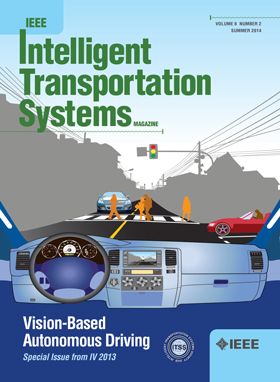考虑时空相关性的随机需求和转弯率下的交通信号协调
IF 8.4
1区 工程技术
Q1 ENGINEERING, CIVIL
IEEE Transactions on Intelligent Transportation Systems
Pub Date : 2024-09-18
DOI:10.1109/TITS.2024.3453495
引用次数: 0
摘要
随机交通需求和转弯率是协调信号控制的关键因素。然而,现有研究忽略了相邻交叉口之间交通流的时空依赖性和信号周期。转弯比率通常被假定为确定性的。本研究为随机交通需求和转弯率下的双向协调自适应信号控制建立了一个两阶段随机编程模型。研究开发了一个分层多目标函数,用于在交通流量过饱和和欠饱和的情况下进行溢出管理和提高运行效率。考虑到协调交通流的时空相关性,主目标函数和次目标函数分别最小化剩余队列长度和平均车辆延误。在第一阶段,对基本协调信号配时方案进行优化,以最大限度地提高随机情况下的预期性能。在第二阶段,通过设置基本绿灯时间的容差系数来确定自适应周期长度和绿灯时间,以维持稳定的交通流。阶段清除可靠性(PCR)的概念被扩展用于解耦两个阶段之间的相互作用。所提模型在一个信号周期内的确定性等效问题被修改为优化基本信号配时方案,以满足一定 PCR 值的随机外生和内生交通需求。设计了一种基于 PCR 的梯度算法来求解。实验结果表明,与六个基准相比,所提出的模型能显著改善交通运行状况。本文章由计算机程序翻译,如有差异,请以英文原文为准。
Traffic Signal Coordination Under Stochastic Demands and Turning Ratios Considering Spatial-Temporal Dependencies
Stochastic traffic demands and turning ratios are critical factors in coordinated signal control. However, existing studies ignore the spatial-temporal dependencies of traffic flows between adjacent intersections and signal cycles. Turning ratios are usually assumed to be deterministic. This study develops a two-stage stochastic programming model for two-way coordinated adaptive signal control under stochastic traffic demands and turning ratios. A hierarchical multi-objective function is developed for overflow management and operational efficiency under both over- and under-saturated traffic. The primary and secondary objective functions minimize residual queue lengths and average vehicle delays, respectively, which are formulated considering spatial-temporal dependencies for the coordinated traffic flow. In stage one, a base coordinated signal timing plan is optimized to maximize the expected performance under stochastic scenarios. In stage two, adaptive cycle lengths and green times are determined by setting the tolerance factor for the base green times to maintain the stable traffic flow. The concept of Phase Clearance Reliability (PCR) is extended to decouple the interaction between the two stages. The deterministic equivalent problem of the proposed model in one signal cycle is modified to optimize the base signal timing plan for serving the stochastic exogenous and endogenous traffic demands up to certain PCR values. A PCR-based gradient algorithm is designed for solutions. The experimental results demonstrate that the proposed model can significantly improve traffic operation compared to six benchmarks.
求助全文
通过发布文献求助,成功后即可免费获取论文全文。
去求助
来源期刊

IEEE Transactions on Intelligent Transportation Systems
工程技术-工程:电子与电气
CiteScore
14.80
自引率
12.90%
发文量
1872
审稿时长
7.5 months
期刊介绍:
The theoretical, experimental and operational aspects of electrical and electronics engineering and information technologies as applied to Intelligent Transportation Systems (ITS). Intelligent Transportation Systems are defined as those systems utilizing synergistic technologies and systems engineering concepts to develop and improve transportation systems of all kinds. The scope of this interdisciplinary activity includes the promotion, consolidation and coordination of ITS technical activities among IEEE entities, and providing a focus for cooperative activities, both internally and externally.
 求助内容:
求助内容: 应助结果提醒方式:
应助结果提醒方式:


